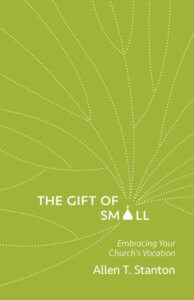In small-membership churches, spiritual formation thrives when it is intentionally embedded in the community’s life. Allen Stanton writes that while church size doesn’t determine the depth of formation, a deep sense of community and a shared story foster virtuous growth. Small churches don’t need to grow in size to fulfill their mission; they can cultivate meaningful formation within their existing structure, celebrating their unique strengths and forming individuals to live out God’s kingdom in everyday life.
Spiritual formation necessarily happens within community. But it is not guaranteed to happen unless it is habituated into the institutional and organizational life of the community. The size of a church does not indicate whether the members of the community are being formed to enact the kingdom of God in their day-to-day lives. But certain traits seem to foster virtuous formation.
In my work, I have found four traits in particular that play an outsized role in the organization and formation of small-membership churches. I am not suggesting that these four attributes are only found in the small-membership church. But while they may be found elsewhere, they are the building block of the default choices available to the small-membership church. They are the intrinsic traits that a smaller congregation will be organized around, whether recognized explicitly or not.
1. A deep sense of community
To start, virtuous formation requires a deep sense of community, going beyond the basic act of belonging to the same congregation. As ethicist Christine Pohl points out, the communities we often inadvertently create are “community on our terms, with easy entrances and exits, lots of choice and support, and minimal responsibilities.” The type of community that can help members learn the traditions and habits of faithfulness requires much more vulnerability, which can be awkward and messy. Sharing a prayer request with a stranger in the pew can be intimidating, even if you belong to the same congregation. However, a community that builds trust, in turn, can both allow for vulnerability and create a space to learn the habits of the church.
2. Leaders that mentor the next generation
Next, there must be leadership that mentors other generations and prepares them to lead. Small-membership churches are well equipped to do this because small-membership churches are organized through their relationships. One of the primary organizational realities of a small congregation is that members know one another. The small-membership church creates a social fabric where each member can be located. This familiarity is particularly useful when forming intergenerational relationships. An older adult and a teenager or young adult are not forging a new relationship but relating to a person they know in a new way. Growing up in a small-membership church, my parents and I were always known in relationship to my grandmother. When I became a teenager looking for leadership roles in the community, the church was a natural place to look. Because I was Jean’s grandson, older members would take me under their wing, teaching me how to play instruments, run sound equipment, and help with church finances. The relational nature of the church ensured that I was part of a network. Mentoring became a natural extension of that network rather than requiring that I build an entirely new one.
3. A sense of story
The third organizational attribute that the formational community needs, and that is native to small congregations, is a sense of story. This narrative will help shape the practices. In turn, it will also set the trajectory for what is to come. For established small-membership churches, the story is easily recognizable. A communal story is not unique to a small-membership church, though it is understood in a different way. In organizational studies, the guiding narrative is referred to as a canonical story, or a community narrative. Stories tell the members of the organization something about themselves, and it is reinforced in myriad ways: pictures, oral traditions, social rituals, and written documents. These are different from a dominant cultural narrative, which is overlayed on a larger culture—for instance the difference between a neighborhood and the rest of a city, or between a town and the wider county. Community stories are shared by members; dominant cultural narratives are communicated through shorthand stereotypes, like when we describe “kids these days” or say “OK, boomer.” Small membership churches are substantially different organizations than other institutions. Inside a larger institution, there are many smaller communities that exist, while smaller congregations are typically composed of a singular relational body. In a small-membership church, individuals are more likely to share in a similar community cultural narrative because there is no other community group than the whole congregation. Learning the community narrative is part of the initiation into the congregation.
4. A shared responsibility for stewarding resources
The final attribute is the ability of all members to share in stewarding the resources of the community. Through this, members of the community can learn the particular social and economic habits of the Christian community. A small-membership church has more accessibility to information about the budget process because small operations need support from all of the members. In my first pastorate, the church council reviewed the finances every month. The church council consisted of around 15 people, roughly a quarter of our average worship attendance. This really meant that practically every family unit in the congregation had at least some representation on the council. The flattened hierarchy also meant that discussions about our resources felt more real. If we were a few thousand dollars under budget, it meant one of the families in that room would be helping to offset that deficit.
Because there was a face associated with each dollar given, we had a deep respect for how we spent our money. It was often unspoken, but our stewardship needed to honor the sacrifices of the members who gave. At times, this can morph into something unhealthy. An upset member might threaten to withhold their money or gifts if they don’t get their way. And, since each person’s offering is needed to sustain the church, this can be a crippling and abusive action. Done well, though, this deeply personal way of relating to a fairly mundane document can help us better picture the economics of the kingdom of God, whereby we are invited into the household of God, where all gifts are given to God’s glory. The intimate nature as a small church, where each gift is valued, can form our imaginations about the economics of what it means to be a Christian community.
Small-membership churches do not need to grow beyond themselves to be vital, formational communities. Rather than seeking to constantly outgrow themselves, they can learn to celebrate that they are already places with important natural gifts. If the mission of the church is to enact the kingdom of God, then the small-membership church is perfectly positioned to be a place of deep theological, ethical, and social formation. They are already big enough for the mission.
Related Resources
 From The Gift of Small: Embracing Your Church’s Vocation (Fortress Press, 2024) by Allen T. Stanton. Adapted and reproduced by permission of Augsburg Fortress Publishers. The book is available through the publisher, Cokesbury, and Amazon.
From The Gift of Small: Embracing Your Church’s Vocation (Fortress Press, 2024) by Allen T. Stanton. Adapted and reproduced by permission of Augsburg Fortress Publishers. The book is available through the publisher, Cokesbury, and Amazon.
Related Resources
- The Gift of Small featuring Allen Stanton — Watch the Leading Ideas Talks podcast video | Listen to the podcast audio version | Read the in-depth interview
- The Rural Church’s Gifts by Michael Adam Beck and Tyler Kleeberg
- The Soul of a Small Church by Lewis A. Parks
If you would like to share this article in your newsletter or other publication, please review our reprint guidelines.






